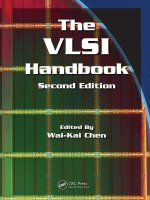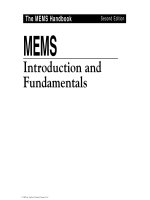Elwes, richard the math handbook everyday math made simple quercus (2011)
Bạn đang xem bản rút gọn của tài liệu. Xem và tải ngay bản đầy đủ của tài liệu tại đây (6.84 MB, 1,063 trang )
www.pdfgrip.com
The Math Handbook
Everyday Math Made Simple
Richard Elwes
www.pdfgrip.com
New York ã London
â 2011 by Richard Elwes
All rights reserved. No part of this
book may be reproduced in any
form or by any electronic or
mechanical means, including
information storage and retrieval
systems, without permission in
writing from the publisher, except
by reviewers,
who may quote brief
www.pdfgrip.com
passages in a review. Scanning,
uploading, and electronic
distribution of this book or the
facilitation of the same without the
permission of the publisher is
prohibited.
The picture credits constitute an
extension to this copyright notice.
Please purchase only authorized
electronic editions, and do not
participate in or encourage
www.pdfgrip.com
electronic piracy of copyrighted
materials. Your support of the
author’s rights is appreciated.
Any member of educational
institutions wishing to photocopy
part or all of the work for
classroom use or anthology should
send inquiries to Permissions c/o
Quercus Publishing Inc., 31 West
57th Street, 6th Floor, New York,
NY 10019, or to
www.pdfgrip.com
ISBN 978-1-62365-294-4
Distributed in the United States and
Canada by Random House
Publisher Services
c/o Random House, 1745
Broadway
New York, NY 10019
Designed and illustrated by Patrick
Nugent
www.pdfgrip.com
PICTURE CREDITS
iStock: 4, 11, 66, 86, 140, 188, 205
Shutterstock: 18, 24, 35, 44, 73, 80,
95, 102, 110, 124, 174, 182, 197,
212
Thinkstock: 50, 57, 117, 148, 156,
166
Patrick Nugent: 132
www.pdfgrip.com
www.quercus.com
www.pdfgrip.com
Contents
Introduction
The language of mathematics
Addition
Subtraction
Multiplication
Division
Primes, factors and multiples
www.pdfgrip.com
Negative numbers and the number
line
Decimals
Fractions
Arithmetic with fractions
Powers
The power of 10
Roots and logs
www.pdfgrip.com
Percentages and proportions
Algebra
Equations
Angles
Triangles
Circles
Area and volume
Polygons and solids
www.pdfgrip.com
Pythagoras’ theorem
Trigonometry
Coordinates
Graphs
Statistics
Probability
Charts
Answers to quizzes
www.pdfgrip.com
Index
www.pdfgrip.com
Introduction
“I was never any good at
mathematics.”
I must have heard this sentence
from a thousand different people.
I cannot dispute that it may be
true: people do have different
strengths and weaknesses, different
interests and priorities, different
opportunities and obstacles. But,
all the same, an understanding of
mathematics is not something
www.pdfgrip.com
anyone is born with, not even
Pythagoras himself. Like all other
skills, from portraiture to computer
programming, from knitting to
playing cricket, mathematics can
only be developed through
practice, that is to say through
actually doing it.
Nor, in this age, is mathematics
something anyone can afford to
ignore. Few people stop to worry
whether they are good at talking or
www.pdfgrip.com
good at shopping. Abilities may
indeed vary, but generally talking
and shopping are unavoidable
parts of life. And so it is with
mathematics. Rather than trying to
hide from it, how about meeting it
head on and becoming good at it?
Sounds intimidating? Don’t panic!
The good news is that just a
handful of central ideas and
techniques can carry you a very
long way. So, I am pleased to
www.pdfgrip.com
present this book: a no-nonsense
guide to the essentials of the
subject, especially written for
anyone who “was never any good
at mathematics.” Maybe not, but
it’s not too late!
Before we get underway, here’s a
final word on philosophy.
Mathematical education is split
between two rival camps.
Traditionalists brandish rusty
compasses and dusty books of log
www.pdfgrip.com
tables, while modernists drop
fashionable buzzwords like
“chunking” and talk about the
“number line.” This book has no
loyalty to either group. I have
simply taken the concepts I
consider most important, and
illustrated them as clearly and
straightforwardly as I can.
Many of the ideas are as ancient as
the pyramids, though some have a
more recent heritage. Sometimes a
www.pdfgrip.com
modern presentation can bring a
fresh clarity to a tired subject; in
other cases, the old tried and tested
methods are the best.
Richard Elwes
www.pdfgrip.com
The language of
mathematics
• Writing mathematics
• Understanding what the various
mathematical symbols mean, and
how to use them
• Using BEDMAS to help with
calculations
www.pdfgrip.com
Let’s begin with one of the
www.pdfgrip.com
commonest questions in any
mathematics class: “Can’t I just
use a calculator?” The answer is
… of course you can! This book is
not selling a puritanical brand of
mathematics, where everything
must be done laboriously by hand,
and all help is turned down. You
are welcome to use a calculator
for arithmetic, just as you can use
a word-processor for writing text.
But handwriting is an essential
skill, even in
today’s hi-tech
www.pdfgrip.com
world. You can use a dictionary or
a spell-checker too. All the same,
isn’t it a good idea to have a
reasonable grasp of basic spelling?
There may be times when you don’t
have a calculator or a computer to
hand. You don’t want to be
completely lost without it! Nor do
you want to have to consult it
every time a few numbers need to
be added together. After all, you
don’t get out your dictionary every
www.pdfgrip.com
time you want to write a simple
phrase.
So, no, I don’t want you to throw
away your calculator. But I would
like to change the way you think
about it. See it as a labor saving
device, something to speed up
calculations, a provider of handy
shortcuts.
The way I don’t want you to see it
is as a mysterious black box which
performs near-magical feats that
www.pdfgrip.com









